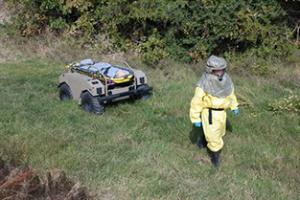First respondersTEEX Center awarded $22 million through DHS national training program
The Texas A&M Engineering Extension Service (TEEX) announced it will receive $22 million in federal funding for its National Emergency Response and Rescue Training Center (NERRTC), which provides specialized homeland security and disaster preparedness training nationwide. Since it was established in 1998, NERRTC has enhanced preparedness by training more than 560,000 emergency responders, senior officials, public works staff, and medical personnel through delivery of more than 13,000 courses to state, local, tribal, and territorial jurisdictions.

Disease outbreak outbreak response with robot training at TEEX // Source: tamu.edu
The Texas A&M Engineering Extension Service (TEEX) announced it will receive $22 million in federal funding for its National Emergency Response and Rescue Training Center (NERRTC), which provides specialized homeland security and disaster preparedness training nationwide.
TEEX notes that the passage of the Department of Homeland Security Appropriations Act for federal fiscal year 2016 provides funding for the National Preparedness Directorate and the National Domestic Preparedness Consortium (NDPC), of which TEEX/NERRTC is a founding member. The new funding is effective 1 October 2016, through 30 September 2018.
NERRTC administers the DHS/FEMA funding provided by the Homeland Security National Training Program Cooperative Agreement, which helps to ensure the United States is prepared to protect citizens and critical infrastructure in case of a major disaster. TEEX says that since it was established in 1998, NERRTC has enhanced preparedness by training more than 560,000 emergency responders, senior officials, public works staff, and medical personnel through delivery of more than 13,000 courses to state, local, tribal, and territorial jurisdictions throughout the fifty states and U.S. territories.
As a primary DHS/FEMA training partner, NERRTC offers training in eleven core competencies: cybersecurity, crisis communications, executive and elected officials’ education, hazardous materials awareness and operations, health and medical services, incident management, infrastructure protection, search and rescue, threat and risk assessment, public works, and training gap analyses.
“NERRTC continues to seek efficiencies that will allow us to increase the number of participants trained each year — more than 59,000 last year — and we continue to add new course offerings to meet the needs of responders nationwide,” said NERRTC Director Hank Lawson. “We now offer 58 courses at no cost to local, state, tribal and territorial jurisdictions under the Cooperative Agreement.”
